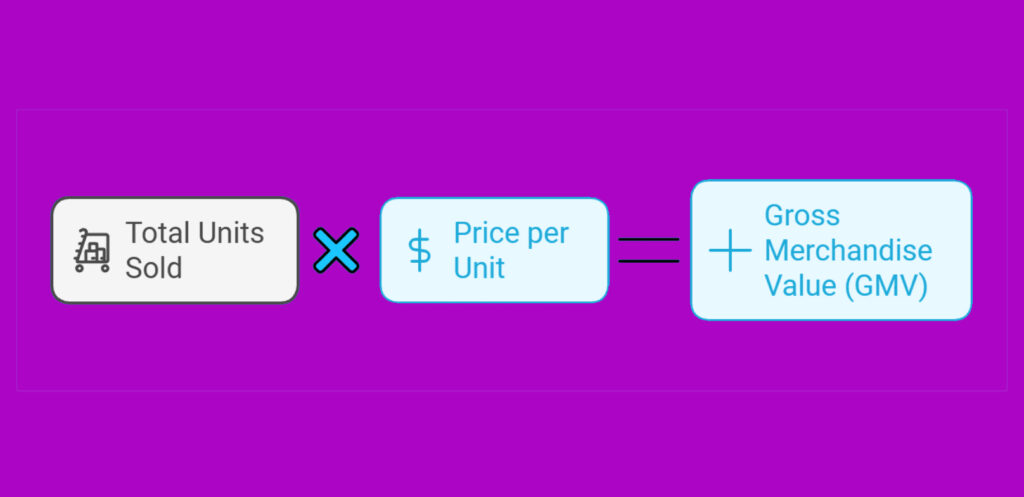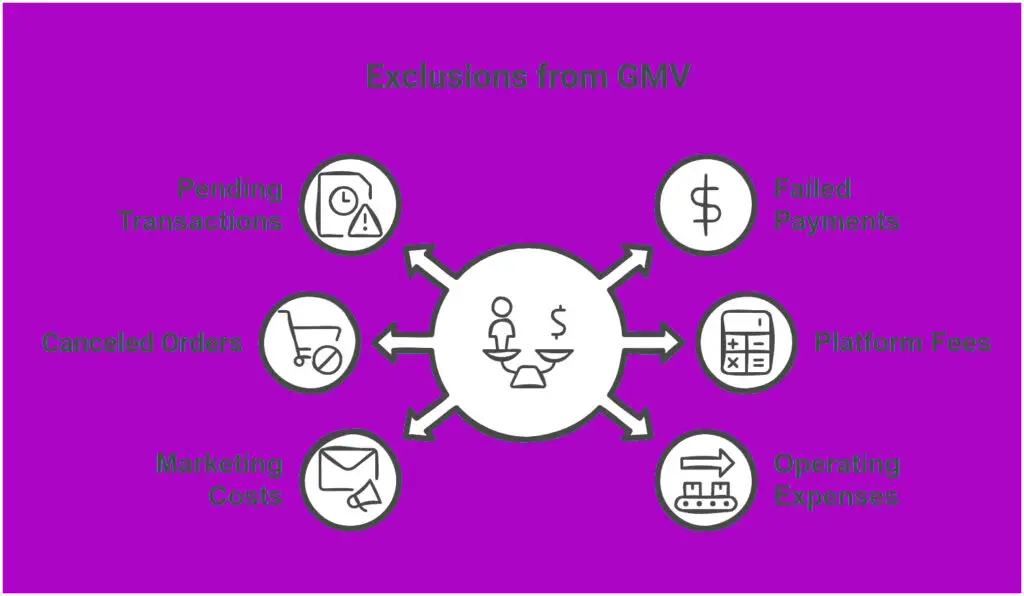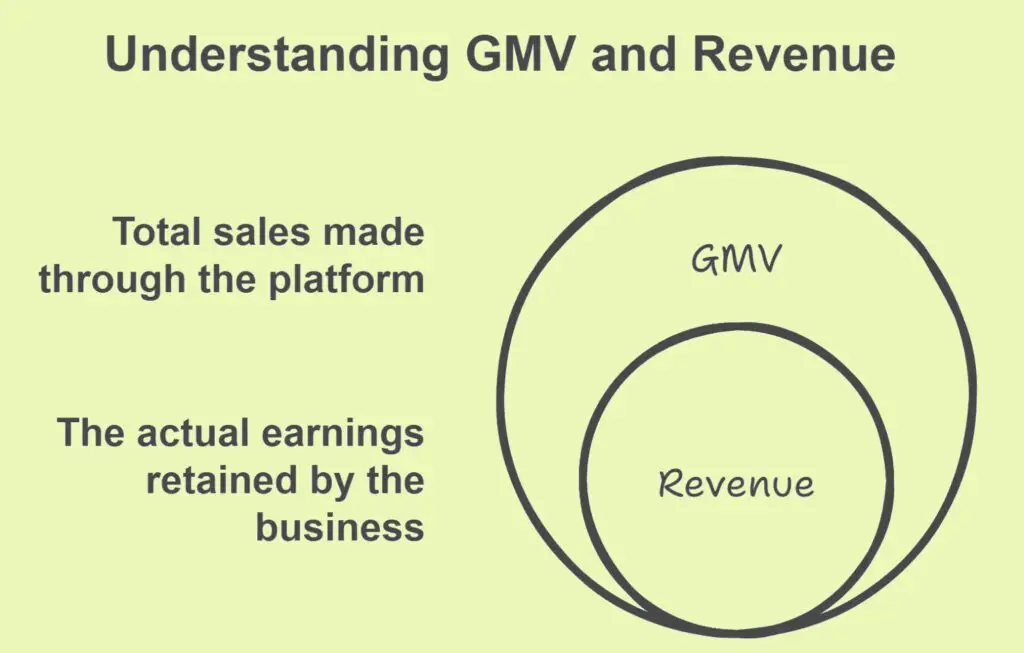Gross Merchandise Value (GMV) is a critical metric in the ecommerce and online marketplace ecosystem. It represents the total value of merchandise sold through a platform within a specific time frame, offering a snapshot of transactional activity. While it doesn’t reflect actual revenue or profit, GMV is often the first number investors and businesses look at when gauging the scale and health of an ecommerce operation.
In this guide, we’ll explore what GMV truly means, how it’s calculated, what it does not include, and why it’s an essential—though sometimes misunderstood—metric in ecommerce analytics.
Understanding GMV: Definition and Purpose
Gross Merchandise Value (GMV) is the total dollar amount of goods sold on a platform, such as an online marketplace or ecommerce store, during a specific period—typically monthly, quarterly, or annually. It measures transactional volume, not profitability, and does not deduct costs such as refunds, shipping, discounts, taxes, or returns.
📌 Important: GMV gives insight into sales activity and business scale but is not a substitute for net revenue or profit.
For ecommerce platforms like Amazon, Etsy, Shopify, and TikTok Shop, GMV is used to indicate performance, assess user engagement, and benchmark growth across different regions or timeframes.
How is GMV Calculated?

The basic GMV formula is:
GMV = Total Number of Units Sold × Price Per Unit
Let’s break this down with an example:
- A marketplace sells 2,000 smartphones priced at $500 each.
- The total GMV = 2,000 × $500 = $1,000,000
This amount reflects the gross sales value before accounting for expenses such as:
- Platform fees or commissions
- Discounts or promotional pricing
- Returns or refunds
- Tax or shipping costs
Thus, GMV captures the “gross” value of sales, not what the platform or seller ultimately earns.
What Does GMV Reveal About a Business?
GMV provides valuable insights that help businesses:
✅ Assess Market Presence
A rising GMV generally signals strong customer interest, higher transaction volumes, and broader market penetration.
✅ Track Consumer Trends
Monitoring GMV across product categories or time periods helps identify trends in buyer behavior—such as rising demand for eco-friendly products or seasonal spikes in purchases.
✅ Benchmark Growth
Comparing GMV over different periods helps businesses understand growth trajectory, effectiveness of marketing campaigns, or expansion into new markets.
✅ Support Strategic Planning
Businesses use GMV projections to model the impact of different pricing strategies, product assortments, and commission structures on top-line growth.
What GMV Doesn’t Include

While GMV is a robust indicator of gross activity, it is not a comprehensive financial metric. Here’s what it excludes:
- ❌ Canceled Orders – Any order canceled before shipment is not part of actual business revenue.
- ❌ Returns & Refunds – Returned items may still appear in GMV if not adjusted, creating an inflated sense of performance.
- ❌ Taxes & Duties – GMV doesn’t include tax obligations or regional levies, which vary across jurisdictions.
- ❌ Shipping Fees – Logistics costs and delivery charges are not reflected in GMV.
- ❌ Platform or Seller Commissions – The actual earnings for the platform (net revenue) are typically a percentage of GMV.
- ❌ Marketing Spend & Operational Costs – Advertising costs, infrastructure, or customer support expenses are excluded from GMV.
GMV vs Revenue: Understanding the Difference
| Metric | GMV | Revenue |
|---|---|---|
| Includes Returns? | ❌ No | ✅ Yes (Net of returns) |
| Accounts for Taxes? | ❌ No | ✅ Yes |
| Reflects Earnings? | ❌ No | ✅ Yes (after deductions) |
| Purpose | Measures gross sales volume | Measures actual income |
| Used by | Marketplaces, investors, analysts | Finance teams, accounting, stakeholders |
🧠 Tip: While GMV shows how much was sold, revenue shows how much was earned.
Why GMV Matters in Ecommerce and Marketplaces
📈 Investor Valuations
Investors often value ecommerce platforms based on multiples of GMV, especially in early stages. For example, a startup generating $100M in GMV might be valued at 1.5x to 3x GMV, depending on growth rate and market dominance.
🌍 Market Expansion Indicators
If a marketplace grows GMV from $5M to $20M in Southeast Asia, it suggests strong traction and regional success—even if revenue lags due to lower commissions or regional discounts.
💡 Strategy and Pricing Models
Platform owners can simulate how altering commission rates affects their cut of GMV. For instance:
- GMV: $50M
- At 5% commission → Revenue = $2.5M
- At 15% commission → Revenue = $7.5M
This modeling helps balance volume growth against profitability targets.
GMV Across Popular Platforms
Different platforms interpret and use GMV based on their business model:
- Amazon: GMV includes third-party seller sales and is a key metric in understanding marketplace performance.
- eBay: GMV helps track item sales across categories and geographies.
- TikTok Shop: GMV reveals the volume and velocity of social commerce transactions, especially among influencers and content creators.
- Alibaba: Uses GMV to showcase economic impact during events like Singles’ Day, where GMV numbers often exceed $70B in 24 hours.
Limitations of GMV
Despite its value, GMV is not a stand-alone metric for measuring business success. It should always be interpreted alongside:
- Net Revenue
- Gross Profit Margin
- Customer Acquisition Cost (CAC)
- Return Rates
- Lifetime Value (LTV)
Relying solely on GMV can create a distorted view of performance, especially if transaction volume is high but margins are low or return rates are excessive.
The Role of GMV in Business Strategy
GMV is a vital performance metric for ecommerce and marketplace businesses, offering insights into scale, sales momentum, and customer activity. However, it must be evaluated in the broader context of financial health, operational efficiency, and long-term profitability.
By understanding what GMV tells you—and what it doesn’t—businesses and stakeholders can make smarter decisions, optimize growth strategies, and better align expectations with actual financial outcomes.
GMV vs Other Business Metrics: A Comprehensive Guide with Real-World Examples
Understanding the nuances between Gross Merchandise Value (GMV) and other financial metrics is essential for anyone involved in ecommerce, SaaS, or digital marketplaces. Each metric tells a different story about business performance. In this guide, we’ll break down GMV versus other key metrics—Revenue, TPV, CTV, Turnover, MRP, and more—using detailed real-world scenarios from an electronics marketplace.
GMV vs Revenue

GMV (Gross Merchandise Value) represents the total value of merchandise sold through a marketplace, regardless of how much of that the platform retains. In contrast, Revenue is the actual income a business earns, typically after taking commissions or markups.
Example: Imagine an electronics marketplace sells 1,000 gaming consoles at $500 each. The GMV would be $500,000. However, if the platform charges a 10% commission, its Revenue would be just $50,000.
Why this matters: GMV shows the total scale of business operations, while revenue reflects profitability and operational efficiency. Reporting both allows investors, analysts, and internal teams to assess scale versus earnings capacity.
GMV vs TPV (Total Payment Volume)

TPV includes every monetary transaction on a platform, not just purchases. GMV, on the other hand, accounts strictly for the value of sold goods.
Example: On the electronics platform:
- A user buys a console for $500 (GMV and TPV).
- Adds $100 to their wallet (only TPV).
- Receives a $50 refund (TPV, not GMV).
TPV = $650 | GMV = $500
Payment processors care more about TPV since they handle all funds, while marketplaces focus on GMV to analyze sales performance.
GMV vs CTV (Customer Transaction Value)

CTV focuses on the average transaction value per customer. GMV is the overall sales value.
Example: Your platform logs $100,000 in monthly GMV. This could mean:
- 200 customers spending $500 each, or
- 20 customers spending $5,000 each.
In both cases, GMV is constant, but CTV varies significantly. High CTV may suggest premium offerings or affluent buyers, while low CTV might point to broader market penetration with lower margins.
GMV vs Turnover

Turnover reflects all business activity, including canceled, returned, or failed transactions, whereas GMV includes only successful sales.
Example: Your daily sales activity is $50,000, but:
- $5,000 in cancellations
- $3,000 in failed payments
- $2,000 in returns
Turnover = $50,000 | GMV = $40,000
Turnover shows gross movement; GMV reflects realized sales. Turnover is often used for internal tracking, while GMV is more investor-facing.
GMV vs MRP (Maximum Retail Price)

MRP is the legally permissible highest price for a product. GMV reflects the actual transaction value.
Example: A gaming console has an MRP of $600 but sells for $500 due to competition. Selling 100 units results in:
- MRP Value = $60,000
- GMV = $50,000
This gap highlights pricing strategy and competitiveness in your market.
Revenue Deep Dive: Definitions and Calculations
Revenue is the cornerstone of financial reporting and profitability. It can be calculated differently based on the business model.
Marketplace Revenue: Revenue = GMV × Commission Rate
Retail Revenue: Revenue = Total Sales – Returns – Discounts
Example:
- Marketplace GMV = $100,000 with 10% commission → Revenue = $10,000
- Retailer Sales = $100,000, Returns = $5,000, Discounts = $2,000 → Revenue = $93,000
Sales vs Revenue

Sales denote the full transaction value. Revenue is what remains after accounting for returns and discounts.
Example: A clothing store reports $10,000 in daily sales. With:
- $1,000 in returns
- $500 in discounts
Revenue = $8,500
This distinction ensures accurate financial forecasting and tax reporting.
Gross Revenue vs Net Revenue

Gross Revenue = Total Earnings (before deductions) Net Revenue = Earnings after all transaction costs
Example:
- Sale = $1,000, 10% Commission = $100 (Gross Revenue)
- Processing Fees = $3, Returns = $2, Chargebacks = $1
Net Revenue = $94
Knowing the difference helps in pricing strategies and profit planning.
Merchandising Revenue
In traditional retail, merchandising revenue is the full product sale value, not just the profit.
Example: Buy at $70, sell at $100 → Revenue = $100, Profit = $30
This is important for accounting and tax purposes, especially under different revenue recognition models.
Profit vs Revenue
Revenue is all income generated. Profit is what remains after deducting all operational costs.
Example: Revenue = $100,000
- Cost of Goods = $60,000
- Salaries = $20,000
- Rent = $10,000
Profit = $10,000
A company with high revenue but low profit must improve efficiency or reduce costs.
GMV and Revenue in the Real World
Understanding how big companies use GMV and Revenue helps benchmark performance.
Amazon (2023):
- GMV: ~$734B
- Revenue: ~$143B
- Take Rate: ~19.5%
TikTok Shop (2023):
- GMV: ~$15B
- Revenue: ~5% of GMV
- Strategy: Rapid growth, low monetization
eBay (2023):
- GMV: ~$73.5B
- Revenue: ~$9.8B
- Take Rate: ~13%
These examples illustrate different monetization strategies and business models.
Tax Implications of GMV and Revenue
Taxation applies to Revenue, not GMV, but understanding both is crucial.
Example:
- GMV: $1M
- Revenue (10% commission): $100,000
Taxes:
- Sales Tax on GMV ($1M), collected from buyers
- Income Tax on Revenue ($100K), paid by the platform
- Merchant taxes on their $900K share
Platforms need to track:
- GMV for transaction audits
- Revenue for income tax
- Total funds for compliance
Platform Reporting Best Practices
For transparency and compliance:
- Report GMV and Revenue separately
- Track cross-border transactions
- Maintain clear commission structures
- Store refund and return data accurately
Example: If your platform grows from $10M to $15M GMV while keeping a 10% commission rate, revenue grows proportionally. This trend signals health to both investors and regulators.
Frequently Asked Questions
Is GMV the same as Volume? No. Volume counts units sold; GMV measures dollar value.
GMV vs ACV (Annual Contract Value)? GMV is the full transaction value. ACV normalizes contracts over one year.
GMV vs Net Sales? Net sales deduct returns/discounts; GMV does not.
GMV vs CTV? GMV is total platform transactions; CTV is average per customer.
Is Turnover the same as GDP? No. Turnover is business-specific; GDP reflects national economic output.
GMV vs MRP? GMV = actual selling price; MRP = legal price cap.
Final Thoughts
GMV is a top-level metric that shows marketplace scale, while revenue demonstrates profitability. For comprehensive business analysis, understanding how GMV compares to related metrics—like revenue, TPV, turnover, and CTV—is essential. Proper interpretation helps guide pricing, taxation, performance tracking, and strategic growth planning.
When used correctly, GMV and revenue offer unparalleled insight into business dynamics, competitive positioning, and long-term sustainability.
